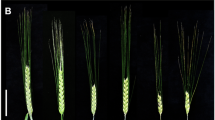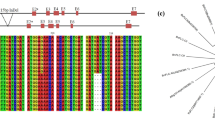Abstract
Key message
The early flowering of Lalu was determined to be due to a novel spontaneous eam8 mutation, which resulted in intron retention and the formation of a putative truncated protein.
Abstract
Barley is a staple crop grown over an extensive area in the Qinghai-Tibetan Plateau. Understanding the genetic mechanism for its success in a high altitude is important for crop improvement in marginal environments. Early flowering is a critical adaptive trait that strongly influences reproductive fitness in a short growing season. Loss-of-function mutations at the circadian clock gene EARLY MATURITY 8 (EAM8) promote rapid flowering. In this study, we identified a novel, spontaneous recessive eam8 mutant with an early flowering phenotype in a Tibetan barley landrace Lalu, which is natively grown at a high altitude of approximately 4000 m asl. The co-segregation analysis in a F2 population derived from the cross Lalu (early flowering) × Diqing 1 (late flowering) confirmed that early flowering of Lalu was determined to be due to an allele at EAM8. The eam8 allele from Lalu carries an A/G alternative splicing mutation at position 3257 in intron 3, designated eam8.l; this alternative splicing event leads to intron retention and a putative truncated protein. Of the 134 sequenced barley accessions, which are primarily native to the Qinghai-Tibet Plateau, three accessions carried this mutation. The eam8.l mutation was likely to have originated in wild barley due to the presence of the Lalu haplotype in H. spontaneum from Tibet. Overall, alternative splicing has contributed to the evolution of the barley circadian clock and in the short-season adaptation of local barley germplasm. The study has also identified a novel donor of early-flowering barley which will be useful for barley improvement.






Similar content being viewed by others
References
Blencowe BJ (2006) Alternative splicing: new insights from global analyses. Cell 126:37–47. doi:10.1016/j.cell.2006.06.023
Boden SA, Weiss D, Ross JJ, Davies NW, Trevaskis B, Chandler PM, Swain SM (2014) EARLY FLOWERING3 regulates flowering in spring barley by mediating gibberellin production and FLOWERING LOCUS T expression. Plant Cell 26:1557–1569. doi:10.1105/tpc.114.123794
Boss PK, Bastow RM, Mylne JS, Dean C (2004) Multiple pathways in the decision to flower: enabling, promoting, and resetting. Plant Cell 16:S18–S31. doi:10.1105/tpc.015958
Budak H, Shearman RC, Parmaksiz I, Gaussoin RE, Riordan TP, Dweikat I (2004) Molecular characterization of buffalograss germplasm using sequence-related amplified polymorphism markers. Theor Appl Genet 108:328–334. doi:10.1007/s00122-003-1428-4
Casas AM, Djemel A, Ciudad FJ, Yahiaoui S, Ponce LJ, Contreras-Moreira B, Gracia MP, Lasa JM, Igartua E (2011) HvFT1 (VrnH3) drives latitudinal adaptation in Spanish barleys. Theor Appl Genet 122:1293–1304. doi:10.1007/s00122-011-1531-x
Dormling I, Gustafsson Å, Jung HR, von Wettestein D (1966) Phytotron cultivation of svalöf’s bonus barley and its mutant svalöf’s Mari. Hereditas 56:221–237
Faure S, Turner AS, Gruszka D, Christodoulou V, Davis SJ, von Korff M, Laurie DA (2012) Mutation at the circadian clock gene EARLY MATURITY8 adapts domesticated barley (Hordeum vulgare) to short growing seasons. Proc Natl Acad Sci USA 109:8328–8333. doi:10.1073/pnas.1120496109
Filichkin SA, Mockler TC (2012) Unproductive alternative splicing and nonsense mRNAs: a widespread phenomenon among plant circadian clock genes. Biol Direct 7:20. doi:10.1186/1745-6150-7-20
James AB, Syed NH, Bordage S, Marshall J, Nimmo GA, Jenkins GI, Herzyk P, Brown JWS, Nimmo HG (2012) Alternative splicing mediates responses of the Arabidopsis circadian clock to temperature changes. Plant Cell 24:961–981. doi:10.1105/tpc.111.093948
Kang S, Xu Y, You Q, Flügel W, Pepin N, Yao T (2010) Review of climate and cryospheric change in the Tibetan Plateau. Environ Res Lett 5:015101. doi:10.1088/1748-9326/5/1/015101
Kikuchi R, Kawahigashi H, Oshima M, Ando T, Handa H (2012) The differential expression of HvCO9, a member of the CONSTANS-like gene family, contributes to the control of flowering under short-day conditions in barley. J Exp Bot 63:773–784. doi:10.1093/jxb/err299
Kolmos E, Herrero E, Bujdoso N, Millar AJ, Tóth R, Gyula P, Nagy F, Davis SJ (2011) A reduced-function allele reveals that EARLY FLOWERING3 repressive action on the circadian clock is modulated by phytochrome signals in Arabidopsis. Plant Cell 23:3230–3246. doi:10.1105/tpc.111.088195
Lincoln S, Daly M, Lander E (1992) Constructing genetic maps with Mapmaker/EXP3.0. Whitehead Institute Technical Report. Cambridge, MA
Lundqvist U (2009) Eighty years of Scandinavian barley mutation genetics and breeding. In: Shu QY (ed) Induced plant mutations in the genomic Era. Food and Agriculture Organization of the United Nations, Rome, pp 39–43
Luo X, Liu X, Yang X, Yuan J, Feng Z (2014) Cloning and tissue expression analysis of HvC4H in hulless barley. J Plant Genetic Resour 15:589–596
Ma DQ, Xu TW, Gu MZ, Wu SB, Kang YC (1987) The classification and distribution of wild barley in Tibet autonomous region. Sci Agric Sin 20:1–6
Michelmore RW, Paran I, Kesseli RV (1991) Identification of markers linked to disease resistance genes by bulked segregant analysis: a rapid method to detect markers in specific genomic regions by using segregating populations. Proc Natl Acad Sci USA 88:9828–9832. doi:10.1073/pnas.88.21.9828
Nakamichi N (2015) Adaptation to the local environment by modifications of the photoperiod response in crops. Plant Cell Physiol 56:594–604. doi:10.1093/pcp/pcu181
Perez-Santángelo S, Schlaen RG, Yanovsky MJ (2013) Genomic analysis reveals novel connections between alternative splicing and circadian regulatory networks. Brief Funct Genom 12:13–24. doi:10.1093/bfgp/els052
Pourkheirandish M, Hensel G, Kilian B et al (2015) Evolution of the grain dispersal system in barley. Cell 162:527–539. doi:10.1016/j.cell.2015.07.002
Rogers SO, Bendich AJ (1985) Extraction of DNA from milligram amounts of fresh, herbarium and mummified plant tissues. Plant Mol Biol 5:69–76. doi:10.1007/BF00020088
Seo PJ, Park MJ, Lim MH, Kim SG, Lee M, Baldwin IT, Park CM (2012) A self-regulatory circuit of CIRCADIAN CLOCK-ASSOCIATED1 underlies the circadian clock regulation of temperature responses in Arabidopsis. Plant Cell 24:2427–2442. doi:10.1105/tpc.112.098723
Sigurbjörnsson B (1975) Methods of mutation induction, including efficiency, and utilization of induced genetic variability. In: Gaul H (ed) Barley Genetics ΙΙΙ. Karl Thiemig, München, pp 84–95
Tamura K, Peterson D, Peterson N, Stecher G, Masatoshi N, Kumar S (2011) MEGA5: molecular evolutionary genetics analysis using maximum likelihood, evolutionary distance, and maximum parsimony methods. Mol Biol Evol 28:2731–2739. doi:10.1093/molbev/msr121
The international barley genome sequencing consortium (2012) A physical, genetic and functional sequence assembly of the barley genome. Nature 491:711–716. doi:10.1038/nature11543
Turner A, Beales J, Faure S, Dunford RP, Laurie DA (2005) The pseudo-response regulator Ppd-H1 provides adaptation to photoperiod in barley. Science 310:1031–1034. doi:10.1126/science.1117619
Varshney RK, Marcel TC, Ramsay L, Russell J, Röder MS, Stein N, Waugh R, Langridge P, Niks RE, Graner A (2007) A high density barley microsatellite consensus map with 775 SSR loci. Theor Appl Genet 114:1091–1110. doi:10.1007/s00122-007-0503-7
Wang X, Wu F, Xie Q, Wang H, Wang Y, Yue Y, Gahura O, Ma S, Liu L, Cao Y, Jiao Y, Puta F, McClung CR, Xu X, Ma L (2012) SKIP is a component of the spliceosome linking alternative splicing and the circadian clock in Arabidopsis. Plant Cell 24:3278–3295. doi:10.1105/tpc.112.100081
Xu T (1982) Origin and evolution of cultivated barley in China. Acta Genet Sin 9:440–446
Zakhrabekova S, Gough SP, Braumann I, Muller A, Lundqvist J, Ahmann K, Dockter C, Matyszczak I, Kurowska M, Druka A, Waugh R, Graner A, Stein N, Steuernagel B, Lundqvist U, Hansson M (2012) Induced mutations in circadian clock regulator Mat-a facilitated short-season adaptation and range extension in cultivated barley. Proc Natl Acad Sci USA 109:4326–4331. doi:10.1073/pnas.1113009109
Acknowledgements
We thank Prof. Xiaogang Ma (Qinghai Academy of Agriculture and Forestry Sciences), Meijin Liu (Gannan Tibetan Autonomous Prefecture Institute of Agricultural Sciences) and Kaijin Yang (Ganzi Tibetan Autonomous Prefecture Institute of Agricultural Sciences) for generously providing the barley germplasm. This research was financially supported by the National Key Research and Development Program (2016YFD0102000), the Chinese Academy of Sciences Associate Scholar Program for the West Light Foundation, the Key research and development and transformation project of Qinghai Province (2016-NK-131), the Qinghai Province Natural Science Foundation (2015-ZJ-915Q) and the Qinghai Province Applied Basic Research Project (2015-ZJ-702).
Author information
Authors and Affiliations
Corresponding authors
Ethics declarations
Conflict of interest
The authors declare that they have no conflict of interest.
Ethical standards
The authors declare that the study complies with the current laws of China.
Additional information
Communicated by Takao Komatsuda.
T. Xia and L. Zhang have contributed equally.
The seed stock of Lalu is available upon request to Yuhu Shen, Northwest Institute of Plateau Biology, Chinese Academy of Sciences, at shenyuhu@nwipb.cas.cn.
Electronic supplementary material
Below is the link to the electronic supplementary material.
122_2016_2848_MOESM1_ESM.pdf
Fig. S1 Alignment of cDNA sequences from Lalu, Diqing and cv. Bonus (JN180296). Variants inducing amino acid substitutions are shown in bold. Following Zakhrabekova et al. (2012), matching residues are indicated by asterisks, conserved substitutions by colons and semi-conserved substitutions by dots. (PDF 63 KB)
122_2016_2848_MOESM2_ESM.tif
Fig. S2 RT-PCR products used for the detection of intron retention in intron 3 of EAM8. 1: Molecular weight marker, L1: Leduheiqingke, 8: accession 86072, 81: accession 86587, I: RT-PCR products amplified with the primer pair α-Tubulin-F/-R, II: RT-PCR products amplified with the primer pair EAM8-1128-F/EAM8-4138-R. (TIF 329 KB)
Rights and permissions
About this article
Cite this article
Xia, T., Zhang, L., Xu, J. et al. The alternative splicing of EAM8 contributes to early flowering and short-season adaptation in a landrace barley from the Qinghai-Tibetan Plateau. Theor Appl Genet 130, 757–766 (2017). https://doi.org/10.1007/s00122-016-2848-2
Received:
Accepted:
Published:
Issue Date:
DOI: https://doi.org/10.1007/s00122-016-2848-2




